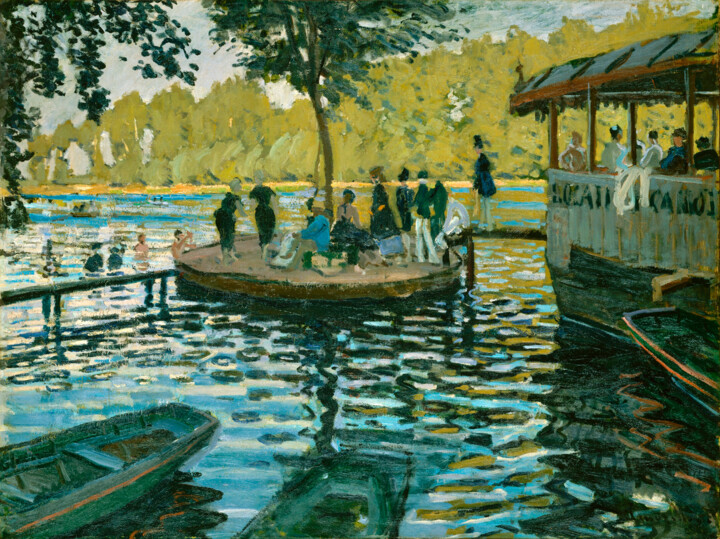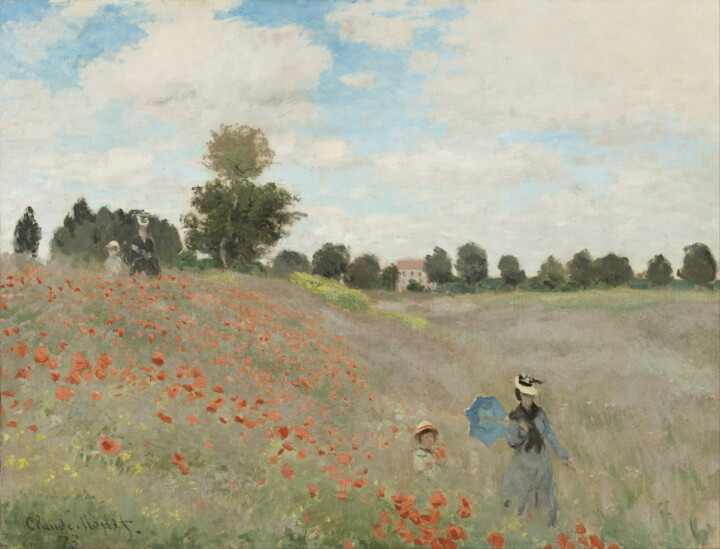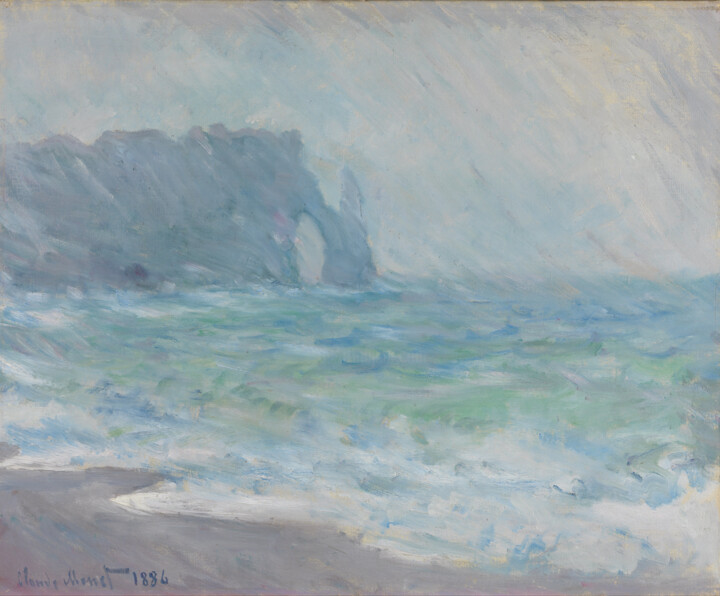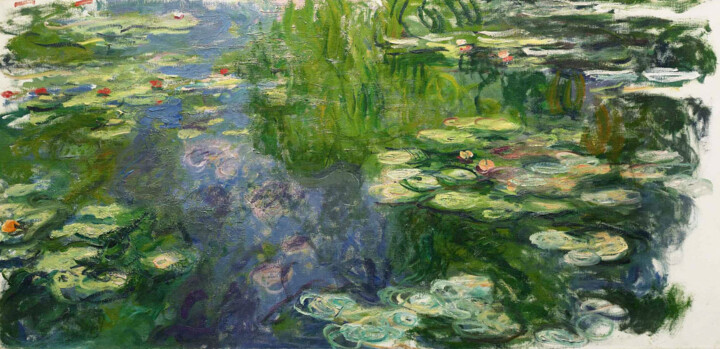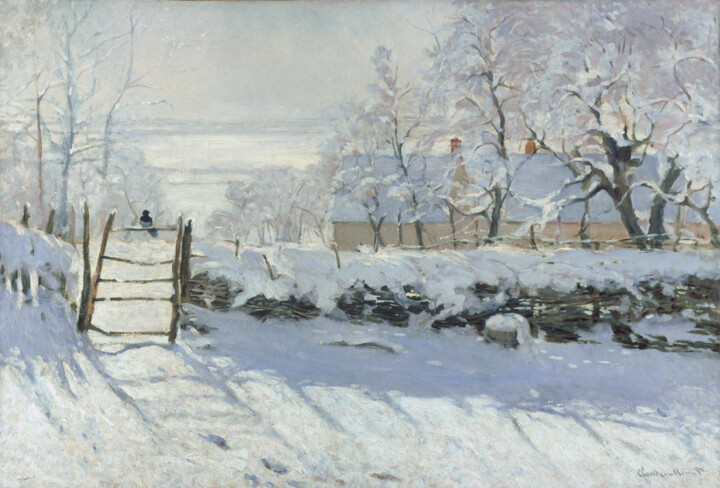 Portrait of Claude Monet, by photographer Nadar, c. 1899
Portrait of Claude Monet, by photographer Nadar, c. 1899
Who was Claude Monet?
Oscar-Claude Monet was a renowned French painter born on November 14, 1840, in Paris. He was a pivotal figure in the development of the Impressionist movement, which sought to capture the fleeting effects of light and atmosphere in their paintings. Monet's early artistic pursuits were met with resistance, as he rejected the rigid academic style of painting and instead embraced a more experimental and observational approach.
In the 1870s, Monet and a group of like-minded artists, including Pierre-Auguste Renoir and Camille Pissarro, began exhibiting their works independently from the official art establishment. They faced criticism for their unconventional techniques, characterized by loose brushstrokes and emphasis on capturing the transient nature of the subject matter. Their first joint exhibition in 1874, which featured Monet's iconic painting "Impression, Sunrise," inadvertently gave rise to the term "Impressionism," as a critic mockingly used it to describe the style.
 Claude Monet: Impression, Sunrise, 1872. Oil on canvas. 48 x 63 cm. Musée Marmottan Monet, Paris
Claude Monet: Impression, Sunrise, 1872. Oil on canvas. 48 x 63 cm. Musée Marmottan Monet, Paris
Monet was particularly fascinated by landscapes, seascapes, and gardens, and his most famous works often depict scenes from his own garden at Giverny. His series of Water Lilies paintings, created during the latter part of his career, are considered some of his greatest achievements.
Despite financial struggles early in his career, Monet's reputation grew steadily over time, and he became one of the most celebrated and influential artists of his era. His contributions to the art world extended beyond his technical innovations; he also played a crucial role in establishing the independent Salon des Refusés, an exhibition that showcased the works rejected by the traditional Salon.
Claude Monet passed away on December 5, 1926, at the age of 86. His legacy endures, with his paintings cherished in museums and private collections worldwide.
The Life of Claude Monet
The life of Claude Monet can be divided into several significant periods that reflect his artistic development and personal experiences:
Early Life and Training: This period encompasses Monet's formative years, from his birth in Paris in 1840 to his early artistic training. During this time, he studied painting in Le Havre and later moved to Paris, where he attended the Académie Suisse and explored different artistic styles and techniques.
Impressionist Movement: This period corresponds to the emergence and growth of the Impressionist movement in the late 19th century. Monet, along with other artists like Renoir, Pissarro, and Degas, rebelled against traditional artistic conventions, emphasizing the portrayal of light, color, and fleeting impressions. It was during this period that Monet's iconic works, such as "Impression, Sunrise," were created.
Argenteuil and Suburban Landscapes: This period covers Monet's time living in Argenteuil, a suburb near Paris, from 1871 to 1878. Inspired by the town's scenic landscapes, he produced numerous paintings capturing the beauty of the countryside, the river, and the changing effects of light. The works from this period exemplify the core principles of Impressionism.
Giverny and the Later Years: This period refers to Monet's move to Giverny in 1883 and his subsequent time spent there until his death in 1926. Giverny became a haven for Monet, where he created his iconic garden and pond, serving as inspiration for his famous Water Lilies series. During this period, Monet's style further evolved, focusing on the exploration of light, color, and atmosphere in his garden and the surrounding natural environment.
These divisions provide a broad framework for understanding the different stages of Monet's life and artistic journey. However, it's important to note that his artistic development was fluid and intertwined with personal experiences, and the boundaries between these periods may not be rigid.
Time in Paris
Claude Monet spent a significant portion of his life in Paris, where he was born and grew up, and which played a crucial role in shaping his artistic journey. As a young artist, Monet studied at the Le Havre secondary school of the arts in Paris before later attending the Académie Suisse.
During his time in Paris, Monet was exposed to various artistic influences and styles. He frequented the Louvre Museum, where he studied and drew inspiration from the works of renowned artists such as Eugene Delacroix and Gustave Courbet. Monet also developed friendships and artistic connections with fellow painters, including Pierre-Auguste Renoir, Camille Pissarro, and Edouard Manet.
In the early years of his career, Monet faced financial struggles and lived in poverty. He moved frequently within the city, often seeking more affordable accommodations. However, he remained determined to pursue his artistic vision and continuously experimented with new techniques and subject matter.
 Claude Monet - Garden at Sainte-Adresse, 1867. Oil on canvas. Metropolitan Museum of Art, New York
Claude Monet - Garden at Sainte-Adresse, 1867. Oil on canvas. Metropolitan Museum of Art, New York
Paris provided Monet with numerous opportunities to exhibit his work. He participated in the official Salon, a prestigious art exhibition organized by the Académie des Beaux-Arts, but faced rejection and criticism for his unconventional style. Along with other like-minded artists, Monet rebelled against the strict artistic conventions and established the independent Impressionist exhibitions, which showcased their works outside the Salon.
It was in Paris that Monet painted some of his iconic cityscapes, including his series of paintings depicting the Rouen Cathedral and the Houses of Parliament in London. These works demonstrated his keen eye for capturing the interplay of light and color in urban environments.
While Monet eventually settled in Giverny, a village outside of Paris, where he created his famous garden and pond that became the inspiration for his Water Lilies series, his time in the bustling city was formative in his artistic development. Paris provided him with artistic inspiration, exposure to new ideas, and connections with fellow artists, contributing to his rise as a leading figure in the art world.
Exile and Argenteuil
Claude Monet's exile and his time in Argenteuil are closely intertwined. In 1870, during the Franco-Prussian War, Monet, like many other artists, fled Paris and sought refuge in England to escape the unrest. He lived in London for a brief period, where he was captivated by the works of British landscape painters and the atmospheric conditions of the city.
After the war, Monet returned to France and settled in Argenteuil, a suburb located northwest of Paris. This picturesque town, situated on the banks of the Seine River, became an important artistic hub for many Impressionist painters, including Monet. The tranquil landscapes, the charming countryside, and the modernization brought about by the railway lines made Argenteuil an ideal location for artists seeking inspiration.
During his time in Argenteuil from 1871 to 1878, Monet produced some of his most celebrated and influential works. The town's scenery provided him with a rich array of subjects, including the river, the bridges, the boating scenes, and the idyllic gardens. He focused on capturing the vibrant play of light, the shimmering reflections on water, and the transient effects of weather and atmosphere.
 Claude Monet - The Luncheon, 1868. Oil on canvas. Städel Museum, Germany
Claude Monet - The Luncheon, 1868. Oil on canvas. Städel Museum, Germany
Monet's time in Argenteuil marked a significant period of artistic exploration and innovation. Along with fellow Impressionists such as Renoir, Sisley, and Manet, he developed and refined the techniques and principles that would define the Impressionist movement. They sought to depict the fleeting qualities of nature, emphasizing the use of broken brushstrokes, vibrant colors, and an emphasis on capturing the momentary sensations and impressions of a scene.
In Argenteuil, Monet's paintings showcased his mastery in capturing the essence of modern life and the shifting nature of perception. His works portrayed leisurely boating parties, bustling railway stations, and the harmony between nature and the man-made environment. Notable pieces from this period include "The Luncheon," "The Bridge at Argenteuil," and "Regatta at Argenteuil."
Although Monet eventually left Argenteuil due to financial difficulties and personal challenges, his time spent in the town left an indelible mark on his artistic development. The vibrant depictions of everyday life and the exploration of light and color that he honed in Argenteuil laid the foundation for his later iconic works, making it a significant chapter in his artistic journey.
Giverny and the Later Years
Claude Monet's time in Giverny holds special significance in his life and artistic career. In 1883, Monet moved to the village of Giverny, located in the picturesque countryside of Normandy, about 50 miles northwest of Paris. He rented a house with a large garden, and over time, he transformed it into a personal paradise and an endless source of inspiration.
Giverny became Monet's sanctuary, a place where he could immerse himself in nature and cultivate his artistic vision. The beautiful gardens, filled with an array of flowers, plants, and a Japanese-inspired water garden, became the subjects of his most famous works. The iconic water lilies, Japanese bridges, and water reflections captivated Monet, and he tirelessly painted various interpretations of these scenes.
 Claude Monet - Water Lilies and the Japanese Bridge, 1897–1899. Oil on canvas. Princeton University Art Museum
Claude Monet - Water Lilies and the Japanese Bridge, 1897–1899. Oil on canvas. Princeton University Art Museum
Monet's obsession with capturing the ever-changing effects of light, color, and atmosphere reached new heights in Giverny. His renowned series of Water Lilies, which he worked on from the late 1890s until his death, showcases his mastery in depicting the ethereal beauty of the pond and its surrounding vegetation. These large-scale paintings, with their bold brushstrokes and harmonious color palettes, invite viewers to immerse themselves in a dreamlike world of tranquility.
Beyond the gardens, Monet also found inspiration in the rural landscapes surrounding Giverny. He painted numerous scenes of meadows, haystacks, and poppy fields, using his signature loose brushwork and capturing the fleeting qualities of nature.
 Claude Monet - Water Lilies, c.1915. Musée Marmottan Monet
Claude Monet - Water Lilies, c.1915. Musée Marmottan Monet
As Monet's reputation grew, so did the number of visitors to Giverny. Admirers flocked to see the gardens that had inspired such remarkable works. Monet's home and gardens eventually became a reflection of his artistic sensibilities, as he carefully curated the spaces to create a harmonious fusion of art and nature.
Claude Monet resided in Giverny until his death on December 5, 1926. His legacy lives on through his art and the preservation of his home and gardens, which are now open to the public as the Fondation Claude Monet. Giverny remains a pilgrimage site for art enthusiasts who seek to experience the enchanting world that inspired one of the greatest Impressionist painters of all time.
Claude Monet and Impressionism
Claude Monet played a central role in the development and popularization of the Impressionist movement. Alongside other like-minded artists, he broke away from the established artistic conventions of the time, focusing on capturing the fleeting effects of light, color, and atmosphere in his paintings.
Monet's innovative approach to painting aligned with the core principles of Impressionism. He emphasized direct observation and the depiction of immediate visual impressions, often opting for open-air painting to capture the changing qualities of natural light. His loose brushwork and use of vibrant colors were aimed at conveying the sensations and transient aspects of a scene.
 Claude Monet - Mouth of the Seine, 1865. Norton Simon Museum, USA
Claude Monet - Mouth of the Seine, 1865. Norton Simon Museum, USA
One of the key characteristics of Monet's Impressionist works was his ability to convey the ever-changing nature of his subjects. Whether it was landscapes, seascapes, or gardens, his paintings reflected the passing of time, with shifting light, weather conditions, and seasons.
Monet's iconic painting "Impression, Sunrise," exhibited in 1874, inadvertently gave the name to the Impressionist movement. This work exemplified the movement's focus on capturing fleeting impressions and the play of light and color.
Impressionism, spearheaded by Monet and his contemporaries, faced initial rejection and criticism from the established art establishment. The artists, including Monet, faced challenges in finding recognition and support for their avant-garde style. They responded by organizing their independent exhibitions, such as the famous Impressionist exhibitions held from 1874 onwards, which provided a platform for them to showcase their works outside the traditional Salon.
Over time, Monet's contributions to Impressionism gained increasing acceptance and appreciation. His dedication to exploring the nuances of light and color inspired subsequent generations of artists and transformed the course of art history. The Impressionist movement, with Monet as one of its leading figures, played a pivotal role in challenging artistic conventions and paving the way for the emergence of modern art.
Today, Monet's Impressionist works are celebrated worldwide, and his legacy continues to influence and inspire artists and art enthusiasts alike. His contributions to the movement remain invaluable, as Impressionism remains one of the most significant and influential art movements in history.

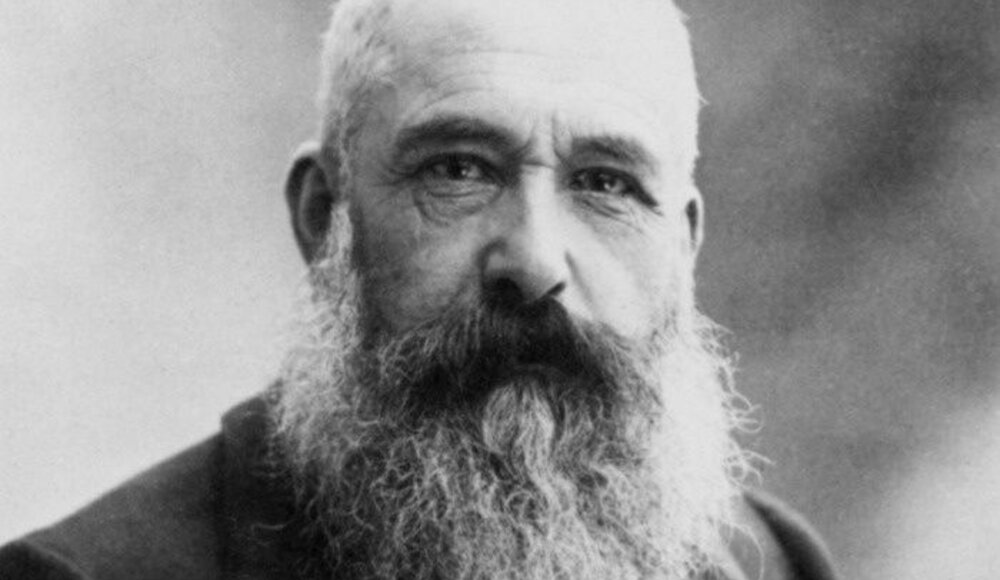
 Selena Mattei
Selena Mattei

